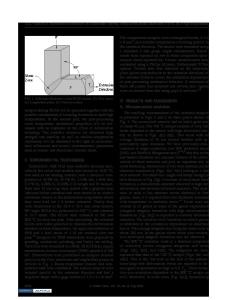A Concise Note on Deformation Twinning and Spall Failure in Magnesium at the Extremes
- PDF / 2,240,425 Bytes
- 13 Pages / 595.276 x 790.866 pts Page_size
- 88 Downloads / 331 Views
S.I. : IMPACT MATTERS: K.T. RAMESH’S 60TH BIRTHDAY
A Concise Note on Deformation Twinning and Spall Failure in Magnesium at the Extremes C. L. Williams1 · D. D. Mallick1 · J. W. Wilkerson2 Received: 13 April 2020 / Accepted: 30 July 2020 © This is a U.S. government work and not under copyright protection in the U.S.; foreign copyright protection may apply 2020
Abstract The high yield strength and low density, potential for further improvements in strength and ductility, and potential for use in defense applications of magnesium and its alloys have garnered serious interest in recent years. However, magnesium and its alloys have also shown a relatively low resistance to void-growth mediated spall failure when compared to other materials such as aluminum, copper, and titanium alloys. The lower spall strength indicates a propensity for failure under tension at the extremes. The common processing methods employed to manufacture these metals may introduce potential void nucleation sites at grain boundaries and second phase inclusions, which can make spall failure more likely. The relationship between the matrix strength and potential void nucleation sites remains largely unexplored in magnesium and its alloys. In this work, the literature regarding experimental observation of deformation mechanisms and spall failure processes active in single crystal and polycrystalline (pure and alloyed) magnesium is explored with a particular emphasis on examining deformation twinning and potential void nucleation sites through ex-situ (postmortem) microscopy. This concise note clearly exposes the need for more research to develop a better understanding of the underlying deformation mechanisms and failure processes active in single crystal and polycrystalline (pure and alloyed) Mg at the extremes. Keywords Twinning · Spall strength · Magnesium alloys · Microstructure · High strain rate · Ex-situ analysis · Recovery
Introduction Under extreme environments such as high stresses, elevated temperatures, and high strain rates, condensed matter can undergo profound structural and property changes. If these changes are properly nurtured, they may lead to novel materials with a strong potential for use in high strain rate structural applications. In recent years, magnesium (Mg) and Mg alloys have gained considerable attention in research activities because of their high ratio of yield strength to density, potential for further improvements in strength and ductility, and potential for use in defense applications [1–3]. Over the past few decades, several researchers have studied the plastic response and failure characteristics of shock compressed Mg in various forms, including single crystals, * C. L. Williams [email protected] 1
US Army CCDC Army Research Laboratory, 321 Colleran Road, Aberdeen Proving Ground, MD 21005‑5066, USA
J. Mike Walker ’66 Department of Mechanical Engineering, Texas A&M University, College Station, TX 77843, USA
2
grain colonies, and Mg-based alloys [4–10]. However, the number of research pa
Data Loading...











